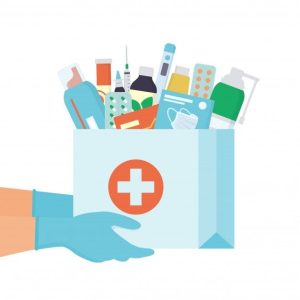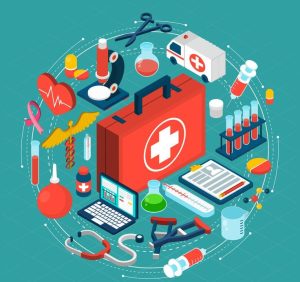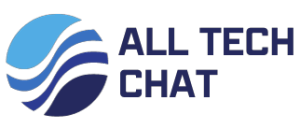What is the Difference Between Medical Device and Medical Technology?
While both terms contribute to healthcare, the key difference lies in their scope:
- Medical devices: Standalone instruments, apparatus, or implants used for diagnosis, treatment, or monitoring of a medical condition. They directly interact with patients, like syringes, pacemakers, or diagnostic imaging machines.
- Medical technology: A broader term encompassing any technology used in healthcare, including medical devices, software, apps, telehealth solutions, and artificial intelligence. It focuses on applying technological advancements to improve healthcare delivery and patient outcomes.
Think of medical devices as the tools, while medical technology is the toolbox encompassing these tools and various other technology-driven solutions.
Understanding Medical Devices
Definition of Medical Devices
Medical devices encompass a wide range of equipment, tools, and apparatus used for medical purposes. These devices are designed to diagnose, prevent, monitor, or treat medical conditions. They vary in complexity, from simple instruments like thermometers to advanced machinery like MRI scanners. Also, read about What is Medical Technology
Examples of Medical Devices
Examples of medical devices include:
- Stethoscopes
- Blood pressure monitors
- Pacemakers
- Surgical instruments
- X-ray machines
Overview of Medical Technology
Definition of Medical Technology
Medical technology refers to the application of scientific knowledge and engineering principles to healthcare. It encompasses a broader spectrum, including medical devices, software, procedures, and systems used to improve patient care, streamline processes, and advance medical research. Discover more information at alltechchat.com
Examples of Medical Technology
Examples of medical technology include:
- Electronic health records (EHR)
- Telemedicine platforms
- Robotic surgery systems
- Artificial intelligence (AI) in healthcare
- Wearable health trackers

Key Differences Between Medical Devices and Medical Technology
Functionality
Medical devices primarily focus on physical tools and equipment used in healthcare settings. They serve specific functions, such as monitoring vital signs, delivering medication, or assisting in surgical procedures. In contrast, medical technology encompasses a broader range of innovations, including software, algorithms, and systems that enhance healthcare delivery and decision-making processes.
Scope of Application
Medical devices are tangible objects with direct applications in patient care, diagnosis, and treatment. They are often utilized within clinical settings under the supervision of healthcare professionals. On the other hand, medical technology encompasses both tangible and intangible components, extending beyond clinical settings to include healthcare administration, research, and education.
Development Process
The development process for medical devices typically involves engineering, manufacturing, and regulatory approvals to ensure safety and efficacy. This process adheres to stringent standards and regulations set forth by regulatory bodies like the FDA. In contrast, medical technology development often involves interdisciplinary collaboration between healthcare professionals, engineers, and software developers to create innovative solutions tailored to specific healthcare challenges.
Regulatory Approval
Medical devices undergo rigorous testing and evaluation before receiving regulatory approval for commercialization and clinical use. Regulatory agencies assess their safety, performance, and effectiveness to ensure they meet quality standards and do not pose risks to patients. Medical technology, especially software-based solutions, also undergoes regulatory scrutiny but may follow different approval pathways depending on their classification and intended use.
Impact on Healthcare Industry
Both medical devices and medical technology play vital roles in shaping the healthcare industry’s landscape. Medical devices contribute to improved patient outcomes, enhanced diagnostic accuracy, and more efficient treatment delivery. Medical technology, on the other hand, drives innovation, promotes data-driven decision-making, and facilitates remote patient monitoring and care coordination.
Importance of Medical Devices
Medical devices are indispensable tools in healthcare, enabling healthcare professionals to diagnose, treat, and manage various medical conditions effectively. From everyday diagnostic tools like thermometers to advanced imaging systems like CT scanners, medical devices play a critical role in delivering quality patient care.
Significance of Medical Technology
Medical technology encompasses a wide range of innovations that revolutionize healthcare delivery and patient outcomes. From digital health platforms that facilitate virtual consultations to AI-powered diagnostic tools that enhance accuracy and efficiency, medical technology empowers healthcare professionals and improves access to care for patients worldwide.
Role in Advancing Healthcare
Both medical devices and medical technology are driving forces behind the advancement of healthcare. They enable personalized medicine, empower patients to take control of their health, and contribute to the shift toward value-based care models. By embracing innovation and leveraging technological advancements, healthcare providers can deliver higher-quality care, improve patient satisfaction, and optimize resource utilization.

Future Trends in Medical Devices and Technology
The future of medical devices and technology holds immense promise, with ongoing advancements in areas such as:
- Miniaturization and wearable technology
- Remote patient monitoring and telehealth
- Precision medicine and personalized healthcare
- Integration of AI and machine learning algorithms
- Blockchain technology for secure health data management
Conclusion
In conclusion, while medical devices and medical technology share the common goal of improving healthcare outcomes, they differ in their scope, functionality, and development processes. Understanding these differences is essential for healthcare stakeholders to leverage the full potential of these innovations in delivering quality patient care and driving positive health outcomes.
FAQs
Are medical devices and medical technology the same thing?
No, although they both contribute to healthcare advancements, medical devices primarily refer to physical tools and equipment, while medical technology encompasses a broader spectrum, including software and systems.
How do regulatory approvals differ for medical devices and medical technology
Regulatory approvals for medical devices involve rigorous testing and evaluation to ensure safety and efficacy, while medical technology, especially software-based solutions, may follow different approval pathways depending on their classification and intended use.
What role do medical devices and medical technology play in healthcare innovation?
Medical devices enable healthcare professionals to diagnose, treat, and manage medical conditions effectively, while medical technology drives innovation, facilitates data-driven decision-making, and improves access to care for patients worldwide.
What are some examples of medical devices and medical technology?
Examples of medical devices include stethoscopes, MRI scanners, and surgical instruments, while medical technology encompasses electronic health records, telemedicine platforms, and AI-powered diagnostic tools.
How can healthcare providers leverage medical devices and medical technology to improve patient care?
Healthcare providers can leverage medical devices and medical technology to deliver personalized medicine, empower patients to manage their health, and optimize resource utilization through remote monitoring and data-driven decision-making.
